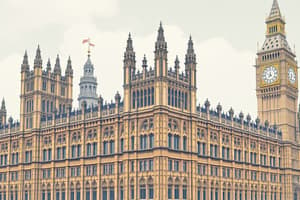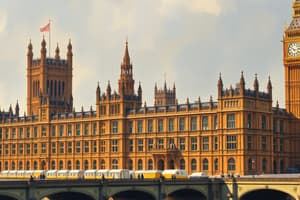Podcast
Questions and Answers
The official residences of monarchs or royal families are often referred to as ______ palaces.
The official residences of monarchs or royal families are often referred to as ______ palaces.
royal
The grand residences of emperors or imperial families are often referred to as ______ palaces.
The grand residences of emperors or imperial families are often referred to as ______ palaces.
imperial
Palaces often feature grand, ornate, and imposing ______, with elements such as domes, towers, and ornate facades.
Palaces often feature grand, ornate, and imposing ______, with elements such as domes, towers, and ornate facades.
architecture
The Palace of Versailles is a former ______ palace with grand halls, gardens, and fountain shows.
The Palace of Versailles is a former ______ palace with grand halls, gardens, and fountain shows.
Palaces have often served as symbols of ______, wealth, and status for ruling families and monarchies.
Palaces have often served as symbols of ______, wealth, and status for ruling families and monarchies.
Buckingham Palace is the official residence of the British ______.
Buckingham Palace is the official residence of the British ______.
The Forbidden City is a complex of ______ palaces in Beijing, once the seat of Chinese emperors.
The Forbidden City is a complex of ______ palaces in Beijing, once the seat of Chinese emperors.
Palaces often house significant cultural and artistic treasures, preserving the history and ______ of a nation or empire.
Palaces often house significant cultural and artistic treasures, preserving the history and ______ of a nation or empire.
Flashcards are hidden until you start studying
Study Notes
Types of Palaces
- Royal Palaces: Official residences of monarchs or royal families, often used for ceremonial and administrative purposes.
- Imperial Palaces: Grand residences of emperors or imperial families, often symbolizing power and wealth.
- Episcopal Palaces: Residences of high-ranking clergy, such as bishops or archbishops, often attached to cathedrals or churches.
Features of Palaces
- Architecture: Palaces often feature grand, ornate, and imposing architecture, with elements such as domes, towers, and ornate facades.
- Gardens and Grounds: Palaces often have extensive gardens, parks, and grounds, which may include fountains, sculptures, and walking trails.
- Interiors: Palaces typically have opulent interiors, with lavish decorations, furnishings, and artwork, including paintings, tapestries, and sculptures.
Famous Palaces
- Palace of Versailles (France): A former royal palace with grand halls, gardens, and fountain shows.
- Buckingham Palace (UK): The official residence of the British monarch, used for ceremonial and administrative purposes.
- Forbidden City (China): A complex of imperial palaces in Beijing, once the seat of Chinese emperors.
Historical Significance
- Symbols of Power: Palaces have often served as symbols of power, wealth, and status for ruling families and monarchies.
- Centers of Government: Palaces have frequently been the seat of government, hosting official events, ceremonies, and meetings.
- Cultural Heritage: Palaces often house significant cultural and artistic treasures, preserving the history and heritage of a nation or empire.
Types of Palaces
- Royal Palaces are the official residences of monarchs or royal families, used for ceremonial and administrative purposes.
- Imperial Palaces are grand residences of emperors or imperial families, symbolizing power and wealth.
- Episcopal Palaces are the residences of high-ranking clergy, such as bishops or archbishops, often attached to cathedrals or churches.
Features of Palaces
- Grand and ornate architecture is a characteristic feature of palaces, with elements such as domes, towers, and ornate facades.
- Palaces often have extensive gardens, parks, and grounds, which may include fountains, sculptures, and walking trails.
- Opulent interiors are typical of palaces, with lavish decorations, furnishings, and artwork, including paintings, tapestries, and sculptures.
Famous Palaces
- The Palace of Versailles in France is a former royal palace with grand halls, gardens, and fountain shows.
- Buckingham Palace in the UK is the official residence of the British monarch, used for ceremonial and administrative purposes.
- The Forbidden City in China is a complex of imperial palaces in Beijing, once the seat of Chinese emperors.
Historical Significance
- Palaces have often served as symbols of power, wealth, and status for ruling families and monarchies.
- Palaces have frequently been the seat of government, hosting official events, ceremonies, and meetings.
- Palaces often house significant cultural and artistic treasures, preserving the history and heritage of a nation or empire.
Studying That Suits You
Use AI to generate personalized quizzes and flashcards to suit your learning preferences.




